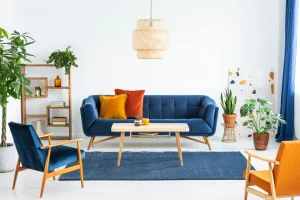The Art of Arrangement: Top Tips for Creating a Functional Living Room Layout

Ever walked into a living room and felt like everything just clicked? That magical balance where style meets function, creating a cozy yet practical space. Crafting such a living room isn’t about splurging on the latest trends—it’s about mastering the art of arrangement. Like a symphony, each piece of furniture plays a part, harmonizing perfectly with its surroundings.
Start with a Plan
Before you dive into rearranging your space, pause for a moment. Think of your living room as a blank canvas. What story do you want it to tell? Jot down your key needs: Is it a family hub? An entertainment zone? Maybe a personal sanctuary? Once you know the function, the form becomes clearer.
Consider crafting a simple sketch or using room layout apps. These tools can offer a bird’s-eye view, helping you visualize possible arrangements without the heavy lifting.
Anchor with a Focal Point
Every great living room has a star. It could be a dramatic fireplace, a grand piano, or even a sweeping window view. Once you’ve identified your focal point, arrange your main seating pieces—like sofas and armchairs—around it. This creates a visual anchor, naturally drawing eyes and conversations towards it.
Embrace Balance and Proportion
Balance isn’t just about symmetry; it’s about harmony. Mix large and small furniture pieces to maintain an even flow without overwhelming the space. Imagine your room as a seesaw—too much weight on one side and it tips over.
- Symmetrical arrangements: Perfect for formal settings.
- Asymmetrical layouts: Ideal for a more casual, dynamic feel.
Prioritize Pathways
A well-designed living room shouldn’t feel like an obstacle course. Ensure there are clear pathways for movement. Leave enough space for people to navigate comfortably, around furniture without feeling cramped. A simple rule? Allow at least 18 inches between coffee tables and sofas for easy access.
Add Layers and Textures
Think of layers as the spices in your design dish. They add depth and interest, transforming a flat layout into a rich tapestry. Consider varying textures with throws, rugs, and cushions—it’s like giving your room a warm hug.
Mixing materials—such as a leather sofa paired with a woven rug or a glass coffee table with a wooden sideboard—can create a captivating contrast that keeps the eye engaged.
Play with Light
Lighting is the unsung hero of room design. It sets the mood, from bright and airy to warm and cozy. Combine different light sources, like floor lamps, table lamps, and pendant lights, to create a layered effect. And remember, natural light is your best friend. Maximize it with light curtains or strategically placed mirrors.
Personalize with Accessories
Your living room should whisper your story. Showcase personal treasures—artwork, travel souvenirs, or beloved books. These unique touches make a house feel like home, sparking joy and conversation.
Keep in mind, too much clutter can overwhelm. Curate your collections, alternating displays seasonally to keep things fresh and exciting.
Final Thoughts
Creating a functional living room layout isn’t just about arranging furniture—it’s about crafting a space that reflects your lifestyle and personality. By blending form with function, you’ll design a living room that’s both beautiful and practical. So, step back, evaluate your space, and let your creativity take the reins. After all, home is where your story begins.
Remember, a functional layout is an evolving journey, not a final destination. Keep experimenting, and don’t be afraid to change things up as your needs evolve.






